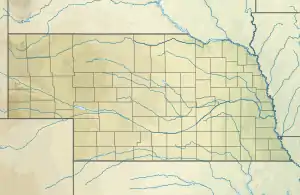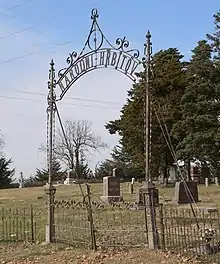Abie, Nebraska
Abie is a village in Butler County, Nebraska, United States. The population was 69 at the 2010 census.
Abie, Nebraska | |
|---|---|
 Downtown Abie | |
 Location of Abie, Nebraska | |
 Abie Location within Nebraska  Abie Location within the United States | |
| Coordinates: 41°20′5″N 96°56′59″W | |
| Country | United States |
| State | Nebraska |
| County | Butler |
| Township | Linwood |
| Area | |
| • Total | 0.11 sq mi (0.28 km2) |
| • Land | 0.11 sq mi (0.28 km2) |
| • Water | 0.00 sq mi (0.00 km2) |
| Elevation | 1,463 ft (446 m) |
| Population | |
| • Total | 69 |
| • Estimate (2019)[3] | 65 |
| • Density | 607.48/sq mi (235.35/km2) |
| Time zone | UTC-6 (Central (CST)) |
| • Summer (DST) | UTC-5 (CDT) |
| ZIP code | 68001 |
| Area code(s) | 402 |
| FIPS code | 31-00205[4] |
| GNIS feature ID | 0826891[5] |
History
Abie was platted in 1877.[6] The applicant for the post office successfully petitioned to have the post office named for his wife, Abigail Stevens.[7][8][9] The Rural Free Delivery was installed in Abie in 1905 with john O. Hasik as carrier. T.B. Semrad succeeded Hasik April 1,1940. He carried the mail on that route until July 15, 1935 when it was consolidated with the Linwood route. The first railroad, The Chicago Northwestern was built in Abie in 1887 at which time the old settlement was moved to the present location in order to be nearer to the railroad. The railroad started a boom in the are which did not end until 1928 although there were few periods of hard times.
The Bank was built in 1904. The School was built 1905. The city hall was Built 1912. The Parish Hall was built 1923. Sokol Hall was Built 1924. The Church was built 1918.
Abie, a settlement of mostly Czech people, was settled in 1869 at the site of the present Catholic Cemetery, It was moved to its present location in 1887. Abie was named after Abigail Stevens wife of Charles Stevens, Abie's first merchant and postmaster. The Czech language is still spoken readily by people in the community.
The Abie milling company was incorporated in 1905. They manufactured the White Lily and pride of Nebraska wheat flowers and Rye Flours. The Abie Flour was known for its high standard of quality and its used exclusively in the area. The flour was also marketed in Omaha, Fremont, Schuyler, Howells, Prague and other surrounding cities and towns.
From the Book Butler County Nebraska History: The Czechs came to Abie in approximately 1869. However, the first settlers were "Yankees" When the Yankees moved out, the German people moved in. They too, left to find more level ground. The Czechs first went to Linwood, then to Abie. A wagon train fo 13 families came to Nebraska from Spillville, IA arriving in July 1869/
The fisrt settlement was located three-fourths of a mile north of the present site. The Catholic Cemetery is located in the original place. The first merchant in the community was Chalres "Yankee" Stevens and the village was named for his wife, Abigail. The mail came from Sounders County and Mr. Stevens was the first postmaster in 1878, a position he held for 10 years.
Since the original town was quite a distance from the railroad when the Chicago and northwestern Railway arrived in 1887, the whole village moved to the new settlement--the present site. The village was laid out by the Western Townsite Co. in July 1887.
Between the years of 14887 and 1928, Abie grew and was quite a business town. There were two general stores, a meat market, hardware-implement business, two grain elevators, two lumber yards, two blacksmith shops, livery stable and dray service. later on there were two service garages, a trucking firm, a bulk oil agency, two taverns, a barber shop and a beauty shop. A school was built in 1871, and later replaced with a larger building in 1905.
The Czech people organized their reading and dramatic clubs shortly after their arrival. The Ted Sokol organization was started in about 1921. This is a group that teaches gymnastics and Czech dances to the young people, The Sokol Auditorium was dedicated in June, 1923, and is presently used for community activities. (Closed in 2017, the building still stands but no longer available for activities).
Despite a few fires and flodds in the past. Abie has maintained a large number of its historic structures. These were surveyed in 1980 by the Nebraska State Historical Society. Despite the loss of the railroad in 1962, the local elevator and a few Abie businesses continue to operate. Teh school continues to operate as well. (the school has since closed and is now known as Abies Place, and small town cafe serving up Czech meals and baking.
Geography
Abie is located at 41°20′5″N 96°56′59″W (41.334744, -96.949657).[10]
According to the United States Census Bureau, the village has a total area of 0.11 square miles (0.28 km2), all land.[11]
Demographics
| Historical population | |||
|---|---|---|---|
| Census | Pop. | %± | |
| 1910 | 210 | — | |
| 1920 | 132 | −37.1% | |
| 1930 | 196 | 48.5% | |
| 1940 | 134 | −31.6% | |
| 1950 | 113 | −15.7% | |
| 1960 | 117 | 3.5% | |
| 1970 | 78 | −33.3% | |
| 1980 | 107 | 37.2% | |
| 1990 | 106 | −0.9% | |
| 2000 | 108 | 1.9% | |
| 2010 | 69 | −36.1% | |
| 2019 (est.) | 65 | [3] | −5.8% |
| U.S. Decennial Census[12] | |||
2010 census
As of the census[2] of 2010, there were 69 people, 34 households, and 19 families living in the village. The population density was 627.3 inhabitants per square mile (242.2/km2). There were 47 housing units at an average density of 427.3 per square mile (165.0/km2). The racial makeup of the village was 100.0% White.
There were 34 households, of which 23.5% had children under the age of 18 living with them, 47.1% were married couples living together, 5.9% had a female householder with no husband present, 2.9% had a male householder with no wife present, and 44.1% were non-families. 32.4% of all households were made up of individuals, and 20.5% had someone living alone who was 65 years of age or older. The average household size was 2.03 and the average family size was 2.53.
The median age in the village was 49.1 years. 15.9% of residents were under the age of 18; 5.8% were between the ages of 18 and 24; 15.9% were from 25 to 44; 40.5% were from 45 to 64; and 21.7% were 65 years of age or older. The gender makeup of the village was 44.9% male and 55.1% female.
2000 census
As of the census[4] of 2000, there were 108 people, 40 households, and 27 families living in the village. The population density was 984.6 people per square mile (379.1/km2). There were 46 housing units at an average density of 419.4 per square mile (161.5/km2). The racial makeup of the village was 100.00% White. Hispanic or Latino of any race were 5.56% of the population.
There were 40 households, out of which 42.5% had children under the age of 18 living with them, 57.5% were married couples living together, 10.0% had a female householder with no husband present, and 32.5% were non-families. 27.5% of all households were made up of individuals, and 17.5% had someone living alone who was 65 years of age or older. The average home size was 2.70 and the average family size was 3.37.
In the village, the population was spread out, with 33.3% under the age of 18, 7.4% from 18 to 24, 30.6% from 25 to 44, 13.0% from 45 to 64, and 15.7% who were 65 years of age or older. The median age was 34 years. For every 100 females, there were 96.4 males. For every 100 females age 18 and over, there were 84.6 males.
As of 2000 the median income for a household in the village was $25,417, and the median income for a family was $23,750. Males had a median income of $30,000 versus $20,833 for females. The per capita income for the village was $12,470. There were 14.7% of families and 9.9% of the population living below the poverty line, including 8.9% of under eighteens and 13.0% of those over 64.

References
- "2019 U.S. Gazetteer Files". United States Census Bureau. Retrieved July 26, 2020.
- "U.S. Census website". United States Census Bureau. Retrieved 2012-06-24.
- "Population and Housing Unit Estimates". United States Census Bureau. May 24, 2020. Retrieved May 27, 2020.
- "U.S. Census website". United States Census Bureau. Retrieved 2008-01-31.
- "US Board on Geographic Names". United States Geological Survey. 2007-10-25. Retrieved 2008-01-31.
- Chicago and North Western Railway Company (1908). A History of the Origin of the Place Names Connected with the Chicago & North Western and Chicago, St. Paul, Minneapolis & Omaha Railways. p. 35.
- Fitzpatrick, Lillian L. (1960). Nebraska Place-Names. University of Nebraska Press. p. 28. ISBN 0803250606.
- "Abie, Butler County". Center for Advanced Land Management Information Technologies. University of Nebraska. Retrieved 31 July 2014.
- Federal Writers' Project (1938). Origin of Nebraska place names. Lincoln, NE: Works Progress Administration. p. 5.
- "US Gazetteer files: 2010, 2000, and 1990". United States Census Bureau. 2011-02-12. Retrieved 2011-04-23.
- "US Gazetteer files 2010". United States Census Bureau. Archived from the original on 2012-07-02. Retrieved 2012-06-24.
- "Census of Population and Housing". Census.gov. Retrieved June 4, 2015.